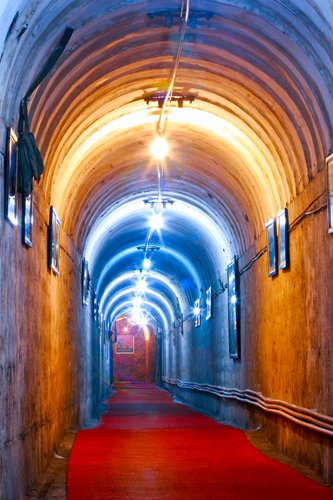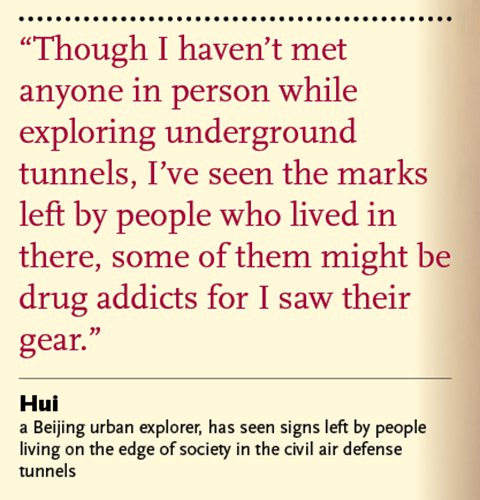


A section of Beijing's civil air defense tunnels in the Qianmen area.
Beijing is building an extensive, complicated network of underground metro routes to accommodate the growing demand for cheap, convenient travel between the city center and its outlying suburbs.
However, few people know that there is an even bigger, more intricate parallel underground world beneath the city, its civil air defense tunnels.
First built in the 1950s, this labyrinth of tunnels is a result of the deteriorating relationship between China and the former Soviet Union during the Cold War, and they were designed to offer shelter for the capital's residents in the case of sudden air attacks or even nuclear strikes from the country's former socialist big brother.

The slogan "People's war" written in Mao Zedong's handwriting is seen on the wall of an air defense tunnel.
China, at that time, had weak air forces compared with the Soviet Union, and therefore was afraid of being unable to defend itself from an attack. Under such conditions, building underground tunnels in major cities was seen as the best solution for the country.
In December 1972, under Chairman Mao's slogan "Dig deep tunnels, store enough food and never seek hegemony," the number of civil air defense tunnels in China rocketed.
The same year, China decided to spend 600 million yuan - a gigantic amount at that time - annually on building these underground cities, with 400 million yuan covered by the central government, and the other 200 million yuan mainly coming from the local government and enterprises.
Ordinary people were asked to join in building these vast defense works, and due to the huge demand for hands, even primary students joined the army of diggers.
Decades later, some underground tunnels have been turned into businesses, or even rented out as homes, while many more have become dilapidated warrens enjoyed by those seeking out the city's forgotten depths.

Memories of childhood
Dashilar, an ancient commercial street adjacent to the Qianmen area just south of Tiananmen Square, is home to the biggest and longest section of underground civil air defense tunnels in Beijing.
Located 8 meters beneath the ground, the civil air defense fortification connects Wangfujing and Tiananmen. In addition to its 70 water sources, it also has 2,300 ventilators and even an underground hospital, movie theater and barbershops. It's exactly true to its name, the Underground City of Beijing.
However, these mysterious underground structures were not just military fortifications but were also a playground for many people born in 1960s.
A Beijing local surnamed Feng, born in 1963, often thinks back to her memories of playing in these bunkers when she was a child.
"Because these tunnels are deep beneath the ground, they are very cool inside especially during the summertime," Feng told the Global Times.
"At that time, it was rare for families to have air-conditioners, so kids loved playing in them to escape the summer heat," she continues.
"One time we got lost after entering an underground tunnel, our teachers and parents were very worried and searched for us for a couple of hours, and then we were forbidden to play in these air defense works," Feng explained.
Paradise of urban exploration
After the threat of bombing passed and people stopped visiting or maintaining them, most of the tunnels became derelict and virtually forgotten.
Though they have fallen out of the mainstream public consciousness, these dark underground fortifications have become a paradise for urban explorers.
Hui, 37, is a self-employed resident of Beijing. He is the organizer behind the Chi Hou urban exploration team, who mainly explore these "red ruins."
According to Hui, he has been thinking about visiting this underground world since he was a primary school student. He said that despite thinking that these dingy underground passageways are depressing, they always aroused great interest in him.
"We mainly visit old civil air defense tunnels outside Beijing, because the old ones in Beijing have been rebuilt or demolished, many big enterprises have their own underground bunkers that are not open for public visits," Hui told the Global Times.
Many of them were built deep in the mountains which ring Beijing and most of them are hard to find, Hui said, explaining the team usually collects information about their location on the Internet before preparing equipment and communication methods.
Though they work as a team, exploring these dilapidated underground mazes is sometimes very dangerous. Once, while exploring a military fortification, they almost fell off a 20-meter-high cliff hidden in the darkness, and they also met spooky skeletons and preserved organs in an abandoned underground hospital.
Hui told the Global Times that the team's members are carefully selected and they use highly specialized equipment to secure their safety.
He recalled that the most impressive place he has explored was an underground radio station frozen in time where all the equipment, such as its microphones and tapes, were well-preserved and the production date of the machines was still easily readable.
Many underground fortifications Hui visited are like time capsules, with slogans on the walls encouraging people to build more underground air defense works and pictures of Chairman Mao on the wall.
Some of these places on the geographic periphery of the city have become home to people who are also at the edge of society.
"Though I haven't met anyone in person while exploring underground tunnels, I've seen the marks left by people who lived in there, some of them might be drug addicts for I saw their gear," Hui told the Global Times.
Lacking any systematic organization, teams like Chi Hou are working individually in different cities that also have similar ruins. Though fewer and fewer "red remains" are left, more and more people are getting interested in exploring them.
"Every time I see ruins or remains of demolished houses, I try to recall their histories, try to feel the prosperity it had, to feel its life and death, its happiness and sorrow," Hui said.
 Fire brigade in Shanghai holds group wedding
Fire brigade in Shanghai holds group wedding Tourists enjoy ice sculptures in Datan Town, north China
Tourists enjoy ice sculptures in Datan Town, north China Sunset scenery of Dayan Pagoda in Xi'an
Sunset scenery of Dayan Pagoda in Xi'an Tourists have fun at scenic spot in Nanlong Town, NW China
Tourists have fun at scenic spot in Nanlong Town, NW China Harbin attracts tourists by making best use of ice in winter
Harbin attracts tourists by making best use of ice in winter In pics: FIS Alpine Ski Women's World Cup Slalom
In pics: FIS Alpine Ski Women's World Cup Slalom Black-necked cranes rest at reservoir in Lhunzhub County, Lhasa
Black-necked cranes rest at reservoir in Lhunzhub County, Lhasa China's FAST telescope will be available to foreign scientists in April
China's FAST telescope will be available to foreign scientists in April "She power" plays indispensable role in poverty alleviation
"She power" plays indispensable role in poverty alleviation Top 10 world news events of People's Daily in 2020
Top 10 world news events of People's Daily in 2020 Top 10 China news events of People's Daily in 2020
Top 10 China news events of People's Daily in 2020 Top 10 media buzzwords of 2020
Top 10 media buzzwords of 2020 Year-ender:10 major tourism stories of 2020
Year-ender:10 major tourism stories of 2020 No interference in Venezuelan issues
No interference in Venezuelan issues
 Biz prepares for trade spat
Biz prepares for trade spat
 Broadcasting Continent
Broadcasting Continent Australia wins Chinese CEOs as US loses
Australia wins Chinese CEOs as US loses